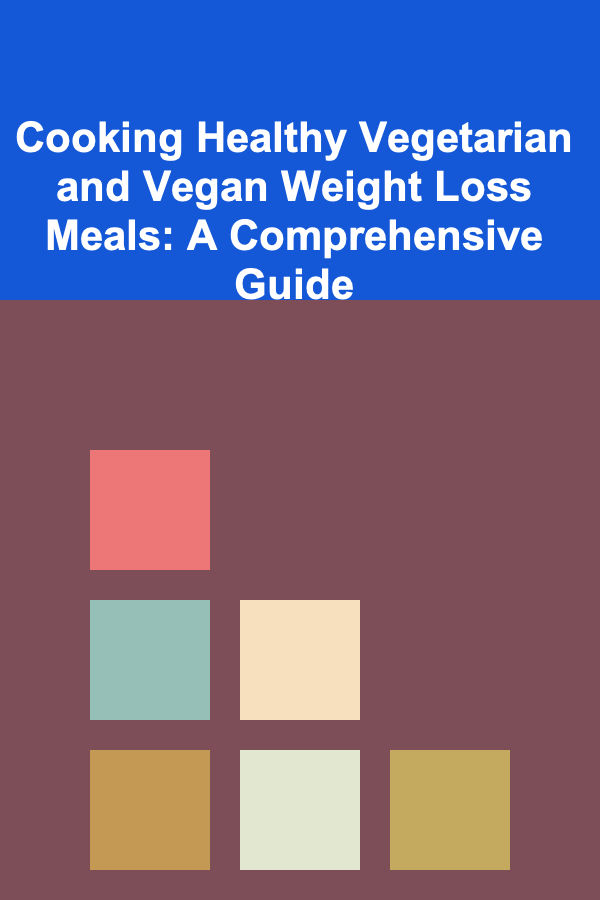
Cooking Healthy Vegetarian and Vegan Weight Loss Meals: A Comprehensive Guide
ebook include PDF & Audio bundle (Micro Guide)
$12.99$7.99
Limited Time Offer! Order within the next:

Embarking on a vegetarian or vegan journey for weight loss can be incredibly rewarding, offering numerous health benefits and aligning with ethical values. However, simply eliminating meat and dairy isn't enough. Success depends on understanding the principles of a balanced, nutrient-dense diet and mastering the art of creating delicious and satisfying meals that support your weight loss goals. This guide provides a comprehensive overview of how to cook healthy vegetarian and vegan meals specifically designed for weight loss, covering everything from macronutrient balance and essential nutrients to practical cooking tips and delicious recipe ideas.
Understanding Vegetarian and Vegan Diets
Before diving into meal preparation, it's crucial to understand the nuances of vegetarian and vegan diets. A vegetarian diet excludes meat, poultry, and fish. Variations include:
- Lacto-ovo vegetarian: Excludes meat, poultry, and fish but includes dairy products and eggs.
- Lacto-vegetarian: Excludes meat, poultry, fish, and eggs but includes dairy products.
- Ovo-vegetarian: Excludes meat, poultry, fish, and dairy products but includes eggs.
A vegan diet is more restrictive, excluding all animal products, including meat, poultry, fish, dairy, eggs, and often honey.
While both diets offer health advantages, they require careful planning to ensure adequate intake of essential nutrients that are typically obtained from animal sources. This is especially important when aiming for weight loss, as calorie restriction can further increase the risk of nutrient deficiencies.
Weight Loss Principles for Vegetarians and Vegans
Weight loss, regardless of dietary preference, fundamentally relies on creating a calorie deficit -- consuming fewer calories than you burn. However, a healthy and sustainable approach goes beyond simple calorie counting. Here's how to apply weight loss principles to vegetarian and vegan diets:
1. Calorie Density and Volume Eating
Focus on consuming foods that are low in calorie density but high in volume. This means prioritizing fruits, vegetables, whole grains, and legumes. These foods provide bulk and fiber, promoting satiety and helping you feel full for longer on fewer calories. For example, a cup of spinach has very few calories compared to a tablespoon of oil, yet the spinach provides significantly more volume and nutrients.
2. Macronutrient Balance
Pay attention to the balance of macronutrients: protein, carbohydrates, and fats. A well-balanced diet will help you feel energized, satisfied, and support muscle maintenance during weight loss.
- Protein: Essential for muscle building and repair, and also highly satiating. Good vegetarian and vegan sources include legumes (beans, lentils, peas), tofu, tempeh, edamame, nuts, seeds, and quinoa. Aim for around 0.8-1.2 grams of protein per kilogram of body weight.
- Carbohydrates: The primary source of energy. Choose complex carbohydrates like whole grains (brown rice, quinoa, oats), starchy vegetables (sweet potatoes, potatoes), and fruits over refined carbohydrates (white bread, sugary drinks). Focus on fiber-rich sources for sustained energy and satiety.
- Fats: Important for hormone production, nutrient absorption, and overall health. Opt for healthy fats like avocados, nuts, seeds, olive oil, and coconut oil in moderation. Be mindful of portion sizes, as fats are calorie-dense.
3. Fiber Intake
Fiber is your best friend for weight loss. It adds bulk to your meals, slows down digestion, regulates blood sugar levels, and promotes healthy gut bacteria. Excellent sources of fiber include:
- Legumes: Beans, lentils, chickpeas, peas
- Whole Grains: Oats, quinoa, brown rice, whole wheat bread
- Fruits: Berries, apples, pears, bananas
- Vegetables: Broccoli, spinach, carrots, Brussels sprouts
- Nuts and Seeds: Chia seeds, flax seeds, almonds, walnuts
4. Hydration
Drink plenty of water throughout the day. Water helps you feel full, aids digestion, and can boost metabolism. Sometimes, thirst can be mistaken for hunger, so staying hydrated can prevent unnecessary snacking. Aim for at least 8 glasses of water per day.
5. Mindful Eating
Pay attention to your hunger and fullness cues. Eat slowly and savor your food, avoiding distractions like TV or phones. Stop eating when you feel satisfied, not stuffed. Mindful eating can help you develop a healthier relationship with food and prevent overeating.
6. Regular Exercise
Combine a healthy diet with regular physical activity. Exercise burns calories, builds muscle, and improves overall health. Aim for at least 150 minutes of moderate-intensity aerobic exercise or 75 minutes of vigorous-intensity aerobic exercise per week, along with strength training exercises at least twice a week.
Essential Nutrients for Vegetarian and Vegan Weight Loss
Certain nutrients require special attention when following a vegetarian or vegan diet, especially when trying to lose weight. Ensure adequate intake of the following:
1. Vitamin B12
Vitamin B12 is primarily found in animal products and is crucial for nerve function and red blood cell formation. Vegans are at high risk of B12 deficiency. Supplementation is highly recommended. Vegetarians can obtain B12 from dairy products and eggs, but supplementation may still be necessary, especially if intake is limited. Look for B12 supplements in the form of methylcobalamin, which is more readily absorbed.
2. Iron
Iron is essential for carrying oxygen throughout the body. While iron is found in plant-based foods, it's in the non-heme form, which is less readily absorbed than heme iron found in animal products. To improve iron absorption, consume iron-rich foods with vitamin C (e.g., spinach with lemon juice). Good vegetarian and vegan sources of iron include:
- Legumes: Lentils, beans, chickpeas
- Dark Leafy Greens: Spinach, kale
- Tofu and Tempeh
- Nuts and Seeds
- Fortified Cereals
3. Calcium
Calcium is vital for bone health, muscle function, and nerve transmission. Dairy is a primary source of calcium for many people. Vegetarians who consume dairy can obtain calcium from this source. Vegans should focus on plant-based sources, including:
- Fortified Plant Milks: Almond milk, soy milk, oat milk
- Tofu (calcium-set)
- Dark Leafy Greens: Kale, collard greens, bok choy
- Broccoli
- Almonds
4. Vitamin D
Vitamin D is important for calcium absorption and bone health. Our bodies produce vitamin D when exposed to sunlight, but many people are deficient, especially during winter months. Vitamin D is also found in some animal products. Vegetarians can obtain some vitamin D from eggs and fortified dairy products. Vegans should rely on fortified plant milks, fortified cereals, and supplementation.
5. Omega-3 Fatty Acids
Omega-3 fatty acids are important for brain health, heart health, and reducing inflammation. The primary omega-3 fatty acids are EPA and DHA, which are primarily found in fatty fish. Plant-based sources contain ALA, which the body can convert to EPA and DHA, but the conversion rate is often low. Good vegetarian and vegan sources of ALA include:
- Flax Seeds and Flaxseed Oil
- Chia Seeds
- Walnuts
- Hemp Seeds
Consider supplementing with an algae-based DHA supplement to ensure adequate intake of EPA and DHA, especially if you are pregnant or breastfeeding.
6. Zinc
Zinc is important for immune function, wound healing, and cell growth. Zinc absorption from plant-based foods can be inhibited by phytates. Soaking or sprouting legumes, grains, nuts, and seeds can reduce phytate content and improve zinc absorption. Good vegetarian and vegan sources of zinc include:
- Legumes: Beans, lentils, chickpeas
- Nuts and Seeds: Pumpkin seeds, cashews
- Whole Grains
- Tofu and Tempeh
Cooking Strategies for Healthy Vegetarian and Vegan Weight Loss Meals
Mastering a few key cooking strategies can make creating healthy and satisfying vegetarian and vegan weight loss meals much easier.
1. Meal Planning and Preparation
Plan your meals for the week in advance. This will help you stay on track, avoid impulse decisions, and ensure you have the necessary ingredients on hand. Prepare ingredients in advance, such as chopping vegetables, cooking grains, and making dressings. This will save time during the week and make it easier to assemble healthy meals.
2. Utilize Versatile Ingredients
Focus on versatile ingredients that can be used in a variety of dishes. For example, lentils can be used in soups, stews, salads, and even as a filling for tacos. Sweet potatoes can be roasted, mashed, or added to smoothies.
3. Flavor Enhancement
Vegetarian and vegan meals can be incredibly flavorful without relying on high-calorie ingredients. Use herbs, spices, lemon juice, vinegar, garlic, and ginger to add depth and complexity to your dishes. Experiment with different flavor combinations to find what you enjoy.
4. Healthy Cooking Methods
Choose healthy cooking methods that minimize added fats and calories. Baking, grilling, steaming, stir-frying with minimal oil, and roasting are all excellent options. Avoid deep-frying or using excessive amounts of oil.
5. Portion Control
Be mindful of portion sizes, even when eating healthy foods. Use smaller plates and bowls to help control portions. Measure out ingredients when cooking to ensure you're not overeating.
6. Smart Snacking
Choose healthy snacks between meals to prevent hunger and maintain stable blood sugar levels. Good options include fruits, vegetables with hummus, nuts, seeds, or a small portion of leftovers.
Delicious Vegetarian and Vegan Weight Loss Recipe Ideas
Here are some recipe ideas to get you started. Remember to adjust portion sizes to meet your individual calorie needs.
Breakfast
- Overnight Oats: Combine oats, plant milk, chia seeds, berries, and a touch of sweetener in a jar. Refrigerate overnight and enjoy in the morning. Add protein powder for extra satiety.
- Tofu Scramble: Crumble tofu and sauté with vegetables like onions, peppers, and spinach. Season with turmeric, nutritional yeast, and black salt for an eggy flavor.
- Green Smoothie: Blend spinach, kale, banana, almond milk, protein powder, and a touch of sweetener for a quick and nutritious breakfast.
- Whole Grain Toast with Avocado and Everything Bagel Seasoning: A simple and satisfying option packed with healthy fats and fiber.
Lunch
- Lentil Soup: A hearty and filling soup made with lentils, vegetables, and spices. Add a squeeze of lemon juice for brightness.
- Quinoa Salad: Combine cooked quinoa with roasted vegetables, chickpeas, herbs, and a light vinaigrette.
- Tofu Salad Sandwich: Mash tofu with vegan mayonnaise, celery, onion, and seasonings. Serve on whole wheat bread or lettuce wraps.
- Buddha Bowl: A colorful bowl filled with brown rice, roasted sweet potatoes, black beans, avocado, and a tahini dressing.
Dinner
- Vegetarian Chili: A flavorful and comforting chili made with beans, vegetables, and spices. Top with avocado and a dollop of vegan sour cream (cashew-based).
- Tofu Stir-Fry: Stir-fry tofu with a variety of vegetables and a flavorful sauce. Serve over brown rice or quinoa.
- Vegetable Curry: A fragrant curry made with coconut milk, vegetables, and spices. Serve with brown rice or naan bread (in moderation).
- Lentil Shepherd's Pie: A plant-based version of a classic comfort food, topped with mashed sweet potatoes.
Snacks
- Apple slices with almond butter
- Carrot sticks with hummus
- A handful of almonds or walnuts
- Edamame
- Air-popped popcorn
Sample Meal Plan for Weight Loss
This is just a sample meal plan; adjust it to fit your individual needs and preferences.
- Monday:
- Breakfast: Overnight Oats with Berries and Protein Powder
- Lunch: Lentil Soup with a Whole Grain Roll
- Dinner: Tofu Stir-Fry with Brown Rice
- Snacks: Apple slices with almond butter, Carrot sticks with hummus
- Tuesday:
- Breakfast: Tofu Scramble with Spinach and Whole Wheat Toast
- Lunch: Quinoa Salad with Roasted Vegetables and Chickpeas
- Dinner: Vegetarian Chili with Avocado
- Snacks: A handful of almonds, Edamame
- Wednesday:
- Breakfast: Green Smoothie
- Lunch: Leftover Vegetarian Chili
- Dinner: Vegetable Curry with Brown Rice
- Snacks: Air-popped popcorn, Carrot sticks with hummus
- Thursday:
- Breakfast: Whole Grain Toast with Avocado and Everything Bagel Seasoning
- Lunch: Tofu Salad Sandwich on Whole Wheat Bread
- Dinner: Lentil Shepherd's Pie
- Snacks: Apple slices with almond butter, A handful of walnuts
- Friday:
- Breakfast: Overnight Oats with Berries and Protein Powder
- Lunch: Buddha Bowl with Brown Rice, Roasted Sweet Potatoes, and Black Beans
- Dinner: Tofu Stir-Fry with Brown Rice
- Snacks: Edamame, Carrot sticks with hummus
Potential Challenges and Solutions
While vegetarian and vegan diets offer numerous benefits, there can be challenges to navigate, especially during weight loss.
- Nutrient Deficiencies: Address this by carefully planning meals and ensuring adequate intake of B12, iron, calcium, vitamin D, omega-3 fatty acids, and zinc. Consider supplementation if needed.
- Social Situations: Plan ahead and bring your own meals or snacks to social gatherings. Research restaurants with vegetarian and vegan options.
- Cravings: Find healthy alternatives to your favorite foods. Experiment with different recipes and flavors.
- Emotional Eating: Identify the triggers for emotional eating and develop healthy coping mechanisms. Consider seeking support from a therapist or counselor.
- Lack of Variety: Explore new recipes and ingredients to keep your meals interesting and prevent boredom.
Conclusion
Cooking healthy vegetarian and vegan weight loss meals is achievable with careful planning, a focus on nutrient-dense foods, and a commitment to mindful eating. By understanding the principles of macronutrient balance, prioritizing fiber intake, and ensuring adequate intake of essential nutrients, you can create delicious and satisfying meals that support your weight loss goals while promoting overall health and well-being. Remember to be patient with yourself, experiment with different recipes, and celebrate your progress along the way. Embrace the journey and enjoy the delicious and rewarding world of vegetarian and vegan cooking!

How to Find Affordable Fitness Solutions
Read More
How to Organize Digital Resources and References
Read More
How to Renovate Your Home's Plumbing and Electrical Systems
Read More
How to Start Investing in Stocks with Little Money
Read More
Understanding Climate Models and Projections
Read More
How to Create Compelling Seasonal Displays That Drive Sales
Read MoreOther Products

How to Find Affordable Fitness Solutions
Read More
How to Organize Digital Resources and References
Read More
How to Renovate Your Home's Plumbing and Electrical Systems
Read More
How to Start Investing in Stocks with Little Money
Read More
Understanding Climate Models and Projections
Read More